Extended honeymoon for endowment portfolios
Over meaningful investment horizons measured in years and decades, markets are influenced by structural shifts in expectations about future trends in inflation and growth. The four decades from 1982 through 2021 were dominated by sustained disinflation and relatively stable growth.
Developed market inflation fell from high teens in 1981 to low single digits in the 2010s, driving above-average returns to bonds, with greater tailwinds for longer duration. Strong growth coupled with a supply-side political orientation generated increasingly higher returns to capital to the detriment of labour, allowing corporations to benefit simultaneously from an expansion in both revenues and margins. While profits surged, they were consistently discounted at ever-lower interest rates, driving a large expansion in multiples and producing windfall gains for equity investors.
Investors in stocks and bonds benefitted from Goldilocks conditions in both asset classes. Better still, because inflation was well contained, economic shocks were exclusively mediated by growth dynamics. For fundamental reasons, equities and bonds respond in opposite directions during economic slowdowns under benign inflation, so bonds offered a superb ballast for stocks during recessions over the past forty years.
The upshot is that the much celebrated “endowment portfolio” characterized by a 60 percent allocation to cap-weighted stocks and a 40 percent allocation to bond composites experienced a four-decade honeymoon. One could be forgiven for believing that this omnipresent portfolio, seemingly indestructible over many decades, can weather any sort of economic storm.
Surviving inflationary storms
Very few investors active today were engaged in markets in the late 1960s and 1970s. This period was in many ways a “bizarro world” version of the past four decades. While the economy and corporate revenues sustained growth rates consistent with the 1980–2020 period, inefficient capital allocation due to ambiguous inflation and policy dynamics; a sustained push by organized labour for higher wages; and a surge in industrial input costs combined with a steady rise in discount rates to transform consistent economic growth into poor asset returns.
From November 1965 through March 1980, a portfolio consisting of 60 percent US total stock market and 40% 10-year Treasury bonds produced approximately 2.1 percent per year in nominal returns. However, after netting out increases in the cost of living, this portfolio annualized at -4.34 percent per year. It’s probably fair to say that back in 1981, exactly no one was interested in investing in passive endowment portfolios.
This prompts the question: how should investors think about portfolio construction while acknowledging periods when inflation is the dominant variable impacting the economy? Perhaps unsurprisingly, commodities have delivered spectacular gains in inflationary environments. Over the past seven inflationary episodes, starting with the termination of World War II in 1946 and ending with the recent COVID shock1 , price levels rose by an average 21 percent. Over the same inflationary episodes, an allocation to broad commodities delivered an average of 36 percent total returns in excess of inflation.
Figure 1. Commodities in inflationary periods
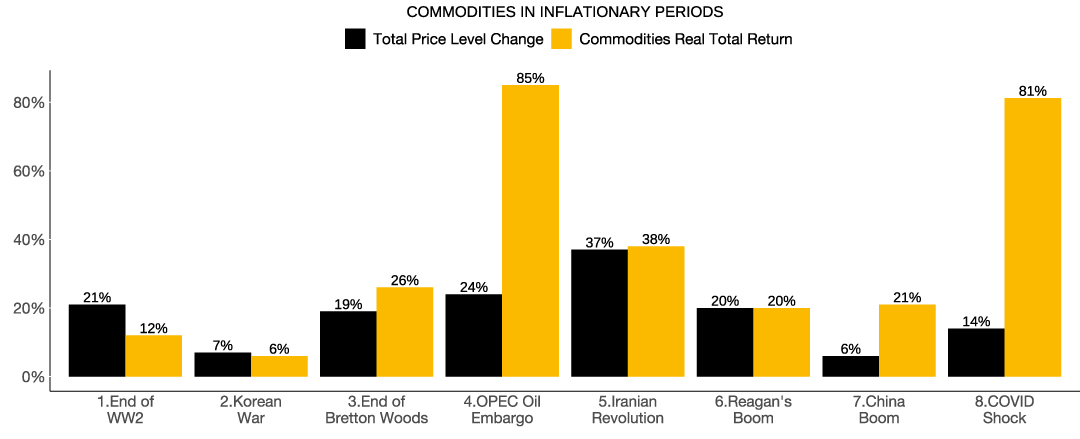
Source: Neville, Henry, Teun Draaisma, Ben Funnell, Campbell R. Harvey, and Otto van Hemert. “The Best Strategies for Inflationary Times.” The Journal of Portfolio Management 47, no. 8 (2021): 8-37.
Commodities’ propensity to deliver strong returns during inflationary shocks – when stocks and bonds struggle together – suggests they most likely deserve a place in strategic portfolio allocations. Portfolios that incorporate stocks and bonds along with inflation-sensitive assets like commodities, and seek to balance risk between these three legs of the stool, are often called “Risk Parity” or “All-Weather” portfolios. This approach to strategic asset allocation is a compelling alternative to traditional endowment portfolios. All-Weather portfolios have a compelling history of strong performance across different market environments and compare favourably to a benchmark endowment portfolio2. A proxy All-Weather strategy3 consisting of equal measures of risk among equity, fixed income, and commodities futures contracts targeting a 10 percent annualized portfolio volatility has compounded at 11.6 percent per annum, yielding a Sharpe ratio of 1.11 since October 1992 (benchmark inception). This compares favourably with the benchmark endowment portfolio, which compounded at 8.1 percent per annum, with a Sharpe ratio of 0.88 over the same period.
Figure 2. All-Weather vs. endowment benchmark, October 1992 – July 2022. HYPOTHETICAL RESULTS
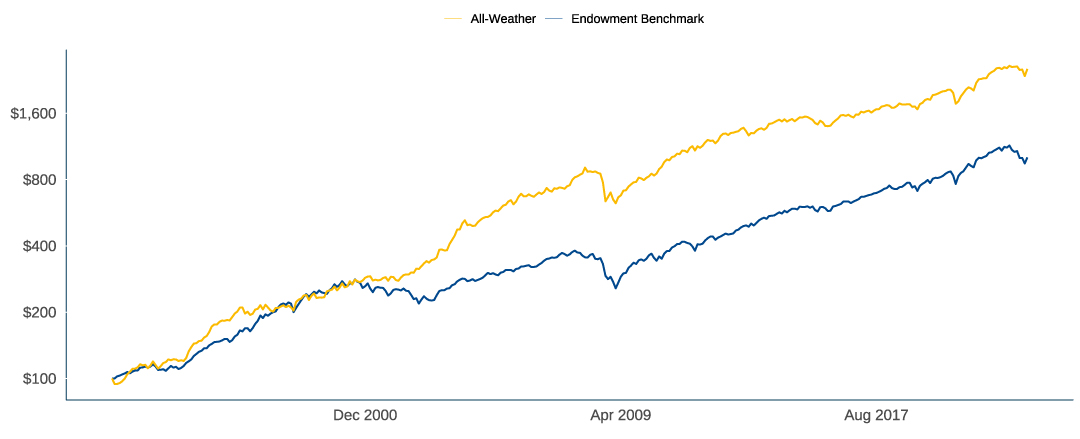
Source: Analysis by ReSolve Asset Management SEZC (Cayman) “ReSolve Global.” Endowment Benchmark is proxied by the Vanguard Balanced Fund Institutional Class (fund symbol VBINX).
Improving the inflation sleeve
While commodities deserve a place in strategic portfolios, they cannot be relied upon to provide ballast in all market environments. Even during sustained inflationary periods, commodities often produce large and painful drawdowns. Commodities4 delivered a total return of 650 percent from 1970 through 1980 but endured a 37 percent peak-to-trough loss in the middle that lasted almost three years. Similarly, during the extended emerging markets growth regime of the 2000s, commodities5 gained 268 percent but inflicted two painful drawdowns of 31 percent and 60 percent, lasting multiple years.
In addition to a passive commodity allocation, investors can also access commodities’ potential to hedge inflation risk by allocating to trend-following commodity trading advisors (CTA Trend). CTA Trend strategies actively manage long and short exposures to commodities, along with other asset classes like equity and bond indices, currencies, and rates, responding to changes in price trends. Many CTA Trend funds have track records extending back to the 1970s.
The ability to take long and short positions in commodities and other global asset classes gives CTA Trend strategies the potential to deliver positive returns in most economic environments and market conditions. Moreover, by following market trends in either direction, independent of macroeconomic biases, CTA Trend managers have historically delivered their best returns during inflationary periods and other instances that are typically challenging to endowment portfolios. For example, over the same seven inflationary episodes presented above, a representative CTA Trend index delivered more reliable gains than passive commodity exposure, with less downside risk.6
Figure 3. Trend-following CTA versus commodities in inflationary periods
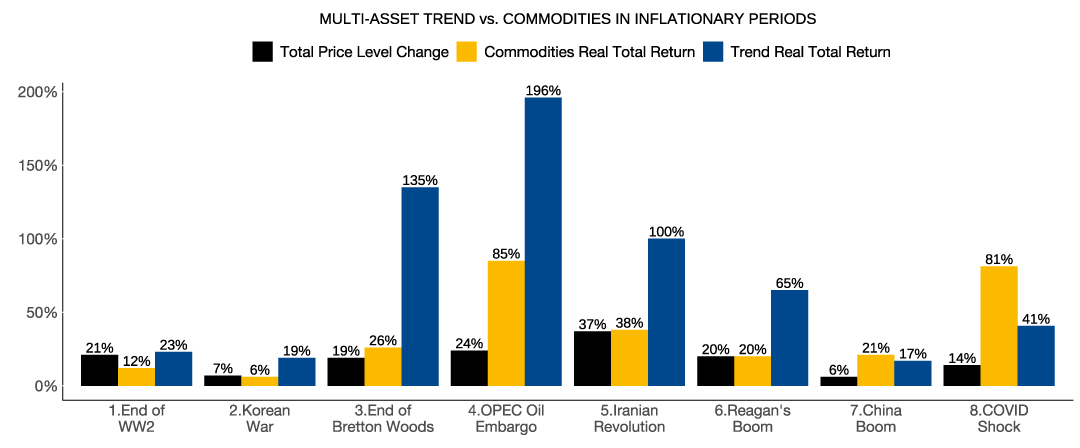
Source: Neville, Henry, Teun Draaisma, Ben Funnell, Campbell R. Harvey, and Otto van Hemert. “The Best Strategies for Inflationary Times.” The Journal of Portfolio Management 47, no. 8 (2021): 8-37.
From All-Weather to All-Terrain investing
CTA Trend strategies are complementary to All-Weather portfolios, but expected performance can be further enhanced with the addition of systematic global macro strategies, which take positions in global futures markets based on factors like carry, relative value, seasonality, and a variety of other risk premia and market anomalies.
Both CTA Trend and systematic global macro strategies have low historical and expected correlations with traditional markets and All-Weather portfolios. Since 1990, the monthly Pearson correlation between the All-Weather strategy and CTA Trend is 0.14; between All-Weather and Systematic Global Macro7 is 0.17; and between CTA Trend and Systematic Global Macro is -0.06.
While diversification is always and everywhere a free lunch that is expected to enhance portfolio risk-adjusted performance in the long term, there are rare occasions when strategy positions overlap and/or systemic risk factors conspire to increase strategy correlations. Tail-hedging strategies, such as passive and active strategies that trade options and volatility linked products, are designed to deliver outsized gains during these hostile market environments. An appropriately sized strategic allocation to tail-hedging strategies can lower overall portfolio downside risk while also providing a source of funding for rebalancing and other activities during acute market crises.
By combining strategic long-only exposures from the All-Weather portfolio with futures-based long/short strategies, like CTA Trend and systematic global macro, and incorporating long-volatility tail hedges, investors can evolve from an All-Weather to an All-Terrain portfolio. A potential All-Terrain portfolio might hold 100 percent in the All-Weather portfolio, allocate another 50 percent both to CTA Trend and Systematic Global Macro, and add a 30 percent overlay to a representative Tail Hedge strategy. By virtue of its structural diversification and exposure to strategies informed by fundamentally different sources of information, the All-Terrain portfolio has the potential to shine more often and through a wider range of market environments.
Figure 4. All-Weather versus All-Terrain versus endowment benchmark, October 1992 – June 2022. HYPOTHETICAL RESULTS.
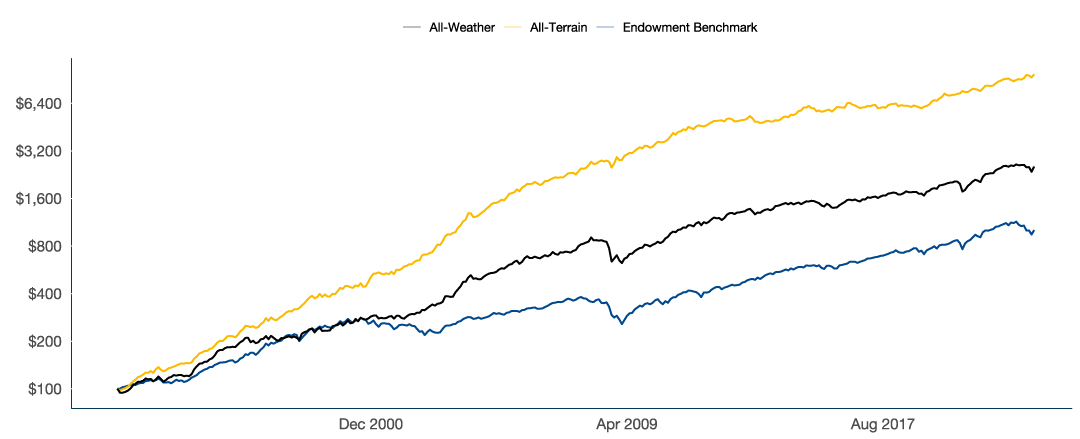
Table 1. Performance table: All-Weather versus All-Terrain versus endowment benchmark, October 1992 – June 2022.
HYPOTHETICAL RESULTS
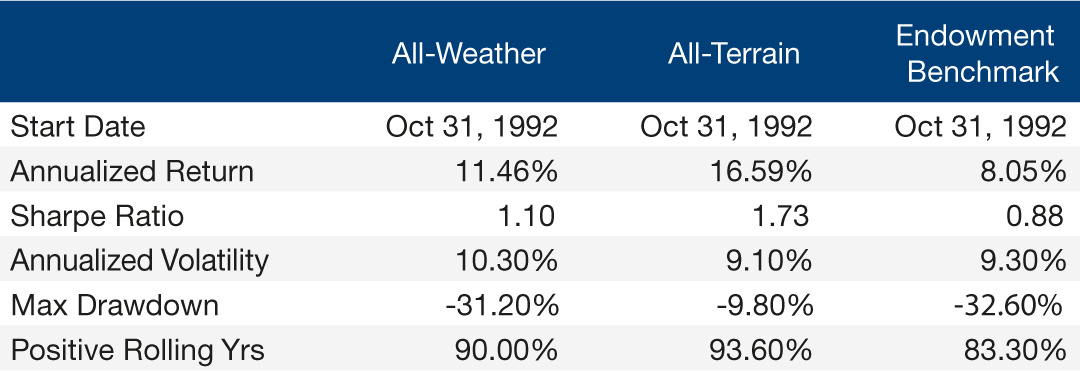
Source: Analysis by ReSolve Global. Endowment Benchmark is proxied by the Vanguard Balanced Fund Institutional Class (fund symbol VBINX).
1 COVID shock spans January 2021 through June 2022, corresponding with the upward shift in slope for the US chained CPI index.
2 Vanguard Balanced Fund Institutional Class total return, US fund symbol VBINX.
3 The All-Weather strategy consists of the S&P Risk Parity Index – 10% Target Volatility (TR) extended using a simple equal risk contribution portfolio of equity, fixed income, and commodity futures contracts. For more information, please see Important Information at the end of this article.
4 Goldman Sachs Commodities Index extended by Global Financial Data from February 1970 through December 1980.
5 Deutsche Bank Optimal Yield Commodities Index from January 2000 through February 2011.
6 Downside risk is measured as peak-to-trough drawdowns. Drawdowns were calculated by ReSolve Global using a trend-following index prepared by AQR as described in: Hurst, Brian, Ooi, Yao Hua, and Lasse Heje Pedersen. “A Century of Evidence on Trend-Following Investing.” The Journal of Portfolio Management 44, no. 1 (2017): 15-29. http://dx.doi.org/10.2139/ssrn.2993026. Index data were extended using the Societe Generale Trend Index from January 2000.
7 See Important Information at the end of this article for details about the Systematic Global Macro Index.
IMPORTANT INFORMATION
COVID Shock
The COVID inflationary shock is defined as the period when the slope of the CPI time-series diverged from its historical trend in January 2021 until June 2022. During the COVID shock, commodities returns were calculated by ReSolve Global using the Invesco Optimum Yield Diversified Commodity Strategy fund (PDBC), and Trend CTA returns were calculated by ReSolve using the Societe Generale Trend Index.
HYPOTHETICAL RESULTS
HYPOTHETICAL PERFORMANCE RESULTS HAVE MANY INHERENT LIMITATIONS, SOME OF WHICH ARE DESCRIBED BELOW. NO REPRESENTATION IS BEING MADE THAT ANY ACCOUNT WILL OR IS LIKELY TO ACHIEVE PROFITS OR LOSSES SIMILAR TO THOSE SHOWN. IN FACT, THERE ARE FREQUENTLY SHARP DIFFERENCES BETWEEN HYPOTHETICAL PERFORMANCE RESULTS AND THE ACTUAL RESULTS SUBSEQUENTLY ACHIEVED BY ANY PARTICULAR TRADING PROGRAM.
ONE OF THE LIMITATIONS OF HYPOTHETICAL PERFORMANCE RESULTS IS THAT THEY ARE GENERALLY PREPARED WITH THE BENEFIT OF HINDSIGHT. IN ADDITION, HYPOTHETICAL TRADING DOES NOT INVOLVE FINANCIAL RISK, AND NO HYPOTHETICAL TRADING RECORD CAN COMPLETELY ACCOUNT FOR THE IMPACT OF FINANCIAL RISK IN ACTUAL TRADING. FOR EXAMPLE, THE ABILITY TO WITHSTAND LOSSES OR TO ADHERE TO A PARTICULAR TRADING PROGRAM IN SPITE OF TRADING LOSSES ARE MATERIAL POINTS WHICH CAN ALSO ADVERSELY AFFECT ACTUAL TRADING RESULTS. THERE ARE NUMEROUS OTHER FACTORS RELATED TO THE MARKETS IN GENERAL OR TO THE IMPLEMENTATION OF ANY SPECIFIC TRADING PROGRAM WHICH CANNOT BE FULLY ACCOUNTED FOR IN THE PREPARATION OF HYPOTHETICAL PERFORMANCE RESULTS AND ALL OF WHICH CAN ADVERSELY AFFECT ACTUAL TRADING RESULTS.
All-Weather Index Construction
The All-Weather Index consists of the S&P Risk Parity Index – 10% Target Volatility (TR) from February 2004 through June 30, 2022 and extended using a simple equal risk contribution portfolio of equity, fixed income, and commodity futures contracts rebalanced monthly and targeting a 10 percent annualized return as described in Risk Parity: Methods and Measures of Success. Returns do not include fees or estimated trading costs.
CTA Trend Strategy Construction
The CTA Trend Strategy consists of returns to the Societe Generale Trend Index from January 2000 through June 2022 and extended from January 1990 through December 1999 using a trend-following index prepared by AQR as described in: Hurst, Brian, Ooi, Yao Hua, and Lasse Heje Pedersen. “A Century of Evidence on Trend-Following Investing.” The Journal of Portfolio Management 44, no. 1 (2017): 15-29. The Societe Generale Index is net of all fees and costs. The AQR extended series is SIMULATED RESULTS and net estimated transaction costs and 2 percent management fees and 20 percent performance fees charged quarterly.
Systematic Global Macro Construction
Systematic Global Macro is proxied by the Bloomberg GSAM Cross-Asset Carry and Value Total Return Index. This index does not account for the gains on trade collateral, trading costs or fees. See Bloomberg GSAM Cross Asset Carry and Value Index for more information.
Tail Hedge Strategy Construction
The Tail Hedge strategy is proxied by EurekaHedge Long Volatility Index from its inception in 2004.
All-Terrain Index Construction
The All-Terrain strategy consists of a 100 percent allocation to the All Weather strategy plus a 50 percent allocation to the CTA Trend Strategy scaled to a long-term volatility of 10 percent using ex post monthly returns; a 50 percent allocation to the Systematic Global Macro Strategy scaled to a long-term volatility of 10 percent using ex post monthly returns; and a 30 percent allocation to the Tail Hedge strategy upon inception in January 2004. Portfolios are rebalanced back to target weights on a monthly basis. No extra fees or costs were deducted aside from what was deducted for the underlying components.

